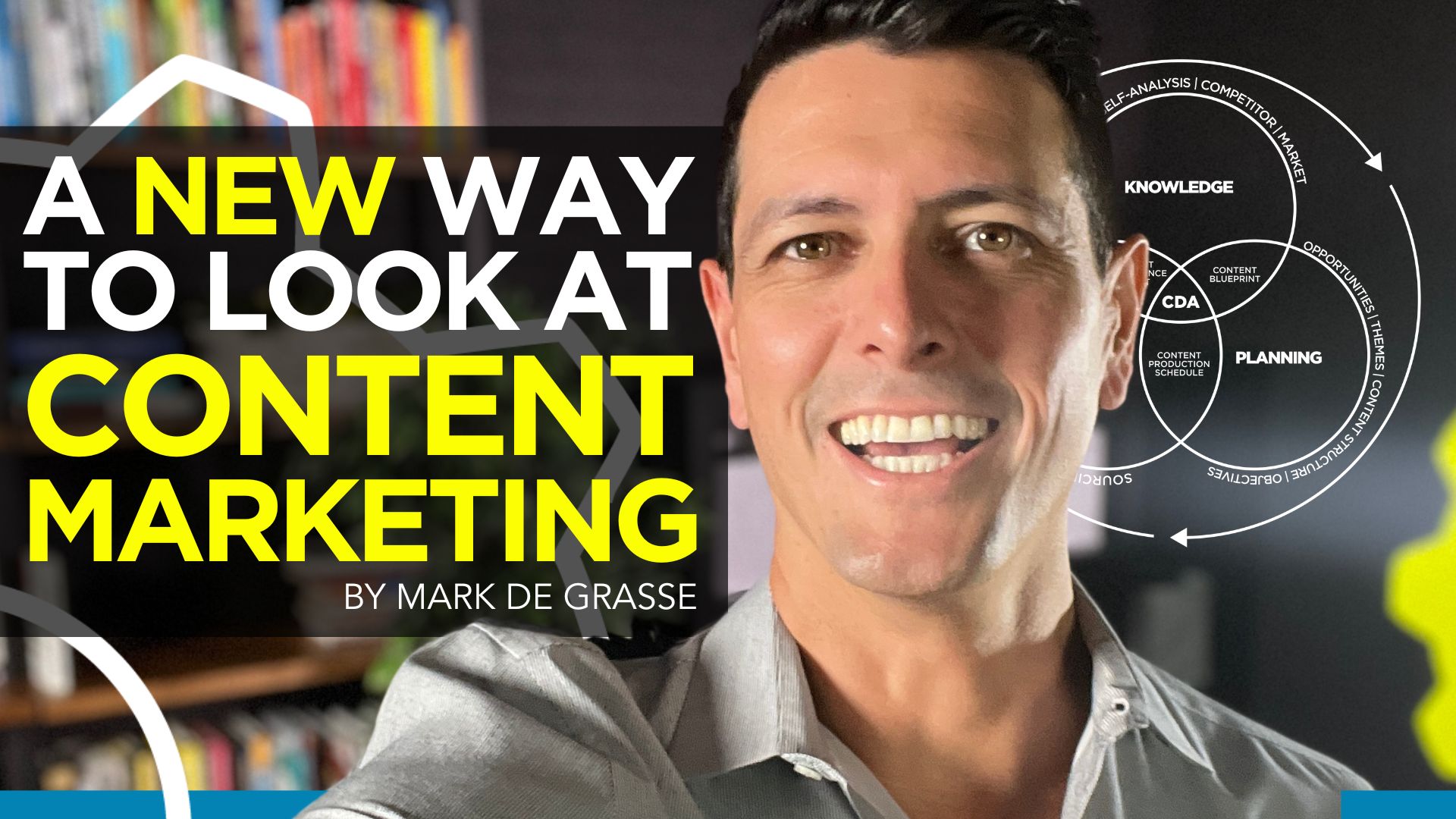MARKETING
A Revolutionary New Way to Look at Content Marketing Strategy

Content marketing has been overly complicated, explained, and misunderstood for TOO LONG. You know your brand needs it, you want to do it, but you’re afraid of wasting time and money on a method you JUST DON’T GET.
How does content lead to sales? How much time and money should you spend on it? Does content really have revenue-driving value?
Before we dive into the solution, let’s define what is and isn’t “content marketing” in the context of our new way of looking at strategy.
What Is and Isn’t Content Marketing

Content Marketing is the process of content creation & organization. Many people confuse it with content distribution, which is the promotion of the content you create through channels like social media marketing, email marketing, and paid media.
Content Marketing is the production of assets to pre-educate potential customers and educate current and former customers regarding useful information about your brand, products, and services.
It’s also the organization of that information to provide a useful resource to your audience and your marketing department.

Want to get certified in Content Marketing?
Leverage the tools and channels to predictably and profitably drive awareness, leads, sales, and referrals—EVERYTHING you need to know to become a true master of digital marketing. Click Here
The content pieces themselves, which we’ll refer to as content assets, include written materials like articles, downloadable documents, and other webpage types, visual materials like graphics, videos, and animations), and audio which is mostly found through Podcasts.
So, What ISN’T Content Marketing?
Content Marketing is not content distribution or community building. Those are separate methodologies that will be touched on in this certification to demonstrate their interaction, but they won’t be discussed in great detail.
So, here’s what content marketing isn’t, in relation to our new approach to content strategy…
- Social Media Posts
- Brand or Marketing Copywriting
- Advertising Copy
So, just to reiterate, content marketing is content production and organization, not distribution.
A New Way to Look at Content Marketing

Rather than thinking about the term itself, let’s think in terms of something we all know at least a little bit about… your dream home.
Real estate has historically been a good investment… dependable appreciation, tax benefits, cash flow, security, and transferability all make buying a home or rental rental property an extremely attractive way to accumulate wealth.
For this example, let’s pretend that you have a trickle of extra income to build your dream home. It’s going to have everything you’ve ever wanted in a home, but you’re going to have to build it piece by piece.
You’ve picked out the perfect piece of land… next you’ll have to pour the foundation, build each room, then install all of the amenities and features you want to make it comfortable. Each component you add to your home adds value.
Even after the home is built, you can add on a pool, jacuzzi, guest house, and a tennis court. You can also add other features like solar panels for energy generation, a water reclamation system, or even a barn for animals to make your home as self-sustainable as possible.
Throughout the whole process your home is appreciating and each addition makes it more valuable. Content is just like your dream home… it’s an asset that you build.
The land is your brand… it starts out completely empty, but it’s in a good location, and you think it will be more valuable once you develop it.
The home itself is your website. It’s where your content will live, and where it will add the most value. All of your work, your assets, should be located here.
This point is extremely important. What happens when all of your content is made on Facebook, TikTok, or Linkedin?
You’re making upgrades to Mark Zuckerberg’s mansion. Don’t worry, you’ll still get that “made by John” tag on the picture you hung on his wall, but it’s enhancing his property value, not yours.
You need to build your home because it’s really the only thing you truly own.
Your dream home can be as big and upgraded as you want it to be. Is it going to be a massive ornate mansion or maybe a minimalistic contemporary structure with the latest tech upgrades?
The truth is that most businesses have a simple structure, just a garage, with almost nothing in it and very few features that add value.
Content marketing is often misunderstood because it’s like real estate… it’s valuable but it takes time, effort, and money to develop, and the big fat payday is some time in the future.
The good news is that, like your dream home, you get value from it every day.
It’s where you live. You keep and organize your possessions there. You show it off to your community to prove how successful you are. It’s an embodiment of your style, knowledge, and how you live your life.
In fact, the whole system we’re describing is called the Content Development & Appraisal framework, as known as the CDA.
The Content Development & Appraisal Framework

The Content Development and Appraisal Framework is a three stage process that will allow you to create endless streams of content in a systematic and scalable manner.
Going back to our real estate analogy, this would be a series of architectural blueprints that you’ll be using to both build and upgrade your dream home.
This plan is intended to help you take meaningful, cohesive action from the start. You’ll learn about your market, create possible concepts, and finally produce cohesive, branded content for online consumption that will drive results for your brand.
The stages of the CDA are Knowledge, Planning, and Production.
Stage 1: Knowledge

During Stage 1 you’ll collect the knowledge you need to make an informed decision about your content.
You’ll research your market, competition, admired brands, and your existing content to learn about your space, find out what’s working, and identify what doesn’t work.
Then you’ll use the data to suggest possible directions for content planning.
Stage 2: Planning

Stage 2 is Planning. The knowledge you gained from the Knowledge stage will guide your general content direction and give you the information you need to identify Content Opportunities and Content Purpose.
Using those pieces of information you’ll define a Content Theme and finally a Content Structure for each objective.
The Content Structure involves defining 5 types of data: Macro-Category, Micro-Category, Content Series, Pillar Pieces, and Support Pieces.
A properly executed Content Structure will yield unlimited amounts of content in a systematic and consistent manner.
Starting with 5-8 Macro-Categories broken down into 3-5 Micro-Categories, you’ll then create 5-10 Content Series (think of them like short-run Netflix shows).
A Content Series is a singular group of information based around a central piece of content called the Pillar Piece. A Pillar Piece is a long-form article, video, or podcast.
The information within the Primary Piece will be used to create Support Pieces in the form of short form articles, videos, and podcasts, in addition to quote graphics, banner, infographics, gifs, and other media types that will eventually be used for distribution through other marketing methods like email marketing, social media marketing, and paid advertising.
You’ll combine the information and results of stages one and two to create your content plan (which we call your Content Blueprint).
Stage 3: Production

Stage 3 is Production. Production is the act of sourcing, collecting, optimizing, and releasing the content specified in your Content Blueprint.
The Content Blueprint will drive the creation of your Content Production Schedule which will define when your new content will be released, and take the resources necessary to source, collect, optimize, and release the content itself into consideration.
After and during stage 3, you’ll be creating Content Performance Reports to identify the best category, pillar piece, and support piece types to consider when you start the new knowledge stage.
As you can see, this is a repeating process that feeds into itself. Each revolution of this process will depend on your business and objectives, but the overall effect will be the same for each business that executes it… that being a consistent flow of content that adds value to your brand.
How to Execute the Content Development & Appraisal Strategy
If all of these terms and processes sound complicated, don’t fret! They’re much simpler than they appear, and the initial perception of complexity will eventually appear both simple and obvious… assuming you complete the new Content Marketing Mastery Certification.
The Content Marketing Mastery Certification has been updated for 2022. It features everything you need to execute the Content Development & Appraisal Strategy, as well as expert content production advice from Julia McCoy for written content, Casey O’Quinn and Matt Brannon for video content, and Luis Diaz for podcast content.

















You must be logged in to post a comment Login